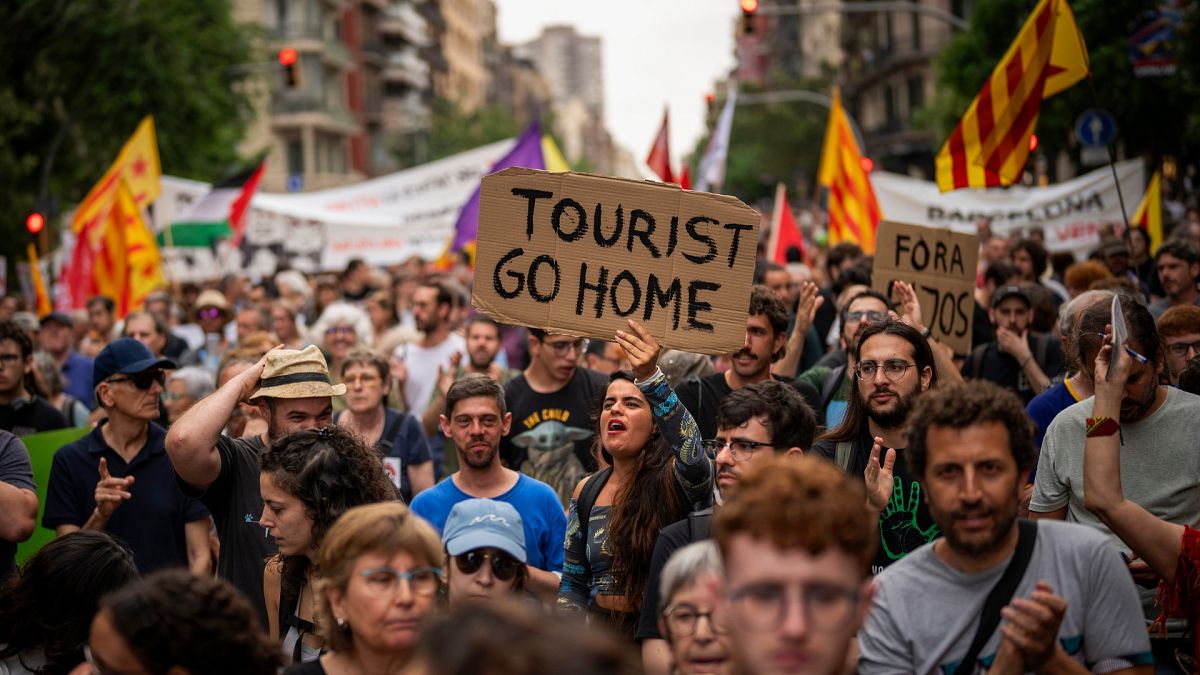Protesters in Barcelona spray visitors with water: Why is tourism no longer so popular in Europe?

Overtourism puts pressure on health services, waste management, water supplies and housing at the expense of the population.
Thousands of Barcelona residents took to the streets to protest against overtourism.
Around 3,000 people from over 140 organizations took to the streets of the Spanish city on Saturday afternoon, splashing tourists with water and shouting “Tourists, go home.” Hotel and restaurant entrances were symbolically blocked.
They are demanding measures ahead of a summer season that experts say will break new records in the city and the entire region of Catalonia. Barcelona is the most visited city in Spain, receiving 12 million people annually, many of whom are Cruise ship.
Increasing visitor numbers place a strain on health care, waste management, water supplies and housing at the expense of local residents. The increasing construction of hotels and housing projects puts historic sites, biodiversity and natural resources at risk.
The city council recently approved an increase in the tourist tax to 4 euros per person from October.
Recently, there has also been a rise in frustration in several other European tourist destinations, forcing local authorities to confront and reassess the relationship between tourists and locals.
From loud graffiti to hunger strikes: This is how travel destinations suffering from overtourism are fighting back.
Spain’s tourist hotspots are struggling with the housing crisis
The worst consequences of overtourism in Spain currently include the lack of housing and rising rental prices for residents.
The residents of Malaga expressed their frustration earlier this year by flooding the centre of the Spanish city with sticker on walls and doors and tell visitors what the residents think of them.
They range from the rather innocuous expressions “this used to be my home” (antes esta era mi casa) and “this used to be the city centre” (antes esto era el centro) to “go the hell home” (a tu puta casa) and “stinks of tourists” (apestando a turista).
The city on the Costa del Sol has long been a popular destination for foreign visitors thanks to its sunny climate and relatively low cost of living, but with digital nomads now also coming to the city, the housing situation has become critical.
The “sticker initiative” was launched by bar owner Dani Drunko. Speaking to local newspaper Diario Sur, Drunko explained that he started the campaign after being “kicked out” of the house where he had lived for ten years.
He claimed that the landlord refused to negotiate the rent or even sell him the property because he wanted to convert it into a short-term rental for tourists.
This development can be observed across the country: landlords have evicted long-term residents in favor of vacationers or driven rents so high that only well-earning digital nomads can afford them. This year protests took place throughout the country from Ibiza to Málaga and Minorca.
A similarly drastic situation prevails on the Canary Islands.
Activists say the more than 10 million foreign visitors who holiday in the archipelago each year are ruining life there, with locals reportedly sleeping in cars and caves due to rising property prices.
A local organization said the islands were “collapsing socially and ecologically” under the pressure of mass tourism.
A report by the organization Eclogists in Action warned that almost 34 percent of the local population – almost 800,000 people – were at risk of poverty or social exclusion.
Residents go on hunger strike over hotel construction on the Canary Islands
The construction of accommodation and services for the flow of tourists in the Canary Islands also places pressures on land use, waste management, water supply and biodiversity.
A group of activists on the Canary Island of Tenerife began a hunger strike against the construction of two new hotels in April this year. They called off the strike after 20 days because the authorities showed “zero interest” in their cause, the strikers said.
The authorities had stopped work on the Hotel La Tejita and Cuna del Alma in Puertito de Adeje on Tenerife. Environment violations, but construction recently resumed.
Canarias Se Agota (The Canaries are sold out) and Canarias se exhausta (The Canary Islands are exhausted) helped organize demonstrations on April 20 in Tenerife, Gran Canaria, Lanzarote and La Palma under the slogan “The Canaries have a limit”.
Tens of thousands of residents protested against mass tourism with signs reading “People live here” and “We don’t want our island to die”.
Protesters in Tenerife called for a limit on the number of tourists on the island.
“The authorities must immediately stop this corrupt and destructive model that is depleting resources and making the economy even more precarious,” Antonio Bullon, one of the protest leaders, told Reuters.
“The Canary Islands have limits and also people’s patience.”
Residents have also put up false signs with the installation of Overcrowding“ to deter tourists in popular locations.
Residents of Venice protest against new entrance fees
Venice is another destination that has long been associated with unsustainable tourist numbers.
The most damaging effect at present is the increasing prevalence of short-term rentals – last year there were more tourist beds in the city than residents.
Locals are faced with a shrinking supply of rental properties and horrendous rental prices.
“Every day we receive people with very serious housing problems: homeless people (often with a job), disabled people living on upper floors without elevators, people living in damp and dilapidated houses that have even been classified as unsanitary by the state health system,” says Susanna Polloni of the Venice-based Solidarity Network for Housing.
The city of Venice has allocated 27.7 million euros for the repair and renovation of around 500 apartments in the historic centre, on the islands and on the mainland.
But there are reportedly around 2,000 properties currently vacant, which Polloni says could have been renovated long ago with better management of resources.
Activists protested the introduction of the new 5-euro note Entrance fee for day trippers on April 25. They said they wanted a different vision for the city that did not focus on tourism.
In the first 11 days that the visitor fee was in force – from April 25 to May 5 – the city sold 195,000 tickets and raised a total of 977,430 euros. The sum far exceeded expectations but is still less than the cost of setting up the online booking system, information campaigns and ticket checks – 3 million euros, according to Italian daily Corriere della Sera.
Members of the Social Assembly for Housing in Venice and the Solidarity Network for Housing criticize the city administration’s spending on the Day trip fee.
“It is a further advance towards the Venice we do not want, the ‘museum city’, a step towards the normalisation of this image which is all the more dangerous the more it penetrates the international imagination,” says Polloni.
“This measure will help make this even more concrete. A city without inhabitants and soul, as the tourist monoculture has now devoured everything that is necessary for the life of a city: housing, sheltered jobs, public services, shops and crafts in the neighborhood.”
After the trial period, the fee can be increased to €10 per day. There are also Fines of up to €300 for those who try to come without a ticket.
The demonstrators are just some of many Venetians who consider the housing plan drawn up by the municipality to be inadequate.
The Council said: proceeds from that Entrance fees are used for services that help the city’s residents, including maintenance, cleaning, and reducing the cost of living.
However, critics say this will do little to curb the influx of tourists, which in turn is one of the main factors behind the depopulation of the Venice.
Austrian village erects fence to prevent tourists from taking selfies
Last year, too, residents resorted to extreme measures to make their feelings heard.
The breathtaking scenery of the city Hallstatt in the Austrian mountains is said to have served as inspiration for Disney’s “Frozen”.
For this reason, over a million tourists flock to this destination every year and many want to take a selfie with the famous view.
Last year, residents of the town were so frustrated that they erected a fence to prevent visitors from taking photographs.
Due to negative reactions on social media, the barrier was later removed, but it was hoped that it would stop people from gathering at a popular selfie spot and disturbing local residents with too much noise.
Activists put up fake warning signs on Mallorca’s beaches
Last summer, activists set up false warning signals on the beaches of Mallorca to keep English-speaking tourists away.
Some posters warned of “dangerous jellyfish,” “falling rocks,” or sea water polluted with sewage.
Others said the beach was closed with a “no swimming” sign underneath, or warned that it would take hours to walk there, even though the sea was less than 100 meters away.
However, a few short lines of text in Catalan underneath revealed to the locals that these warnings were not serious.
They explained that “the problem is not a rockfall, but mass tourism“ or that the “beach is open except for foreigners and jellyfish.”



